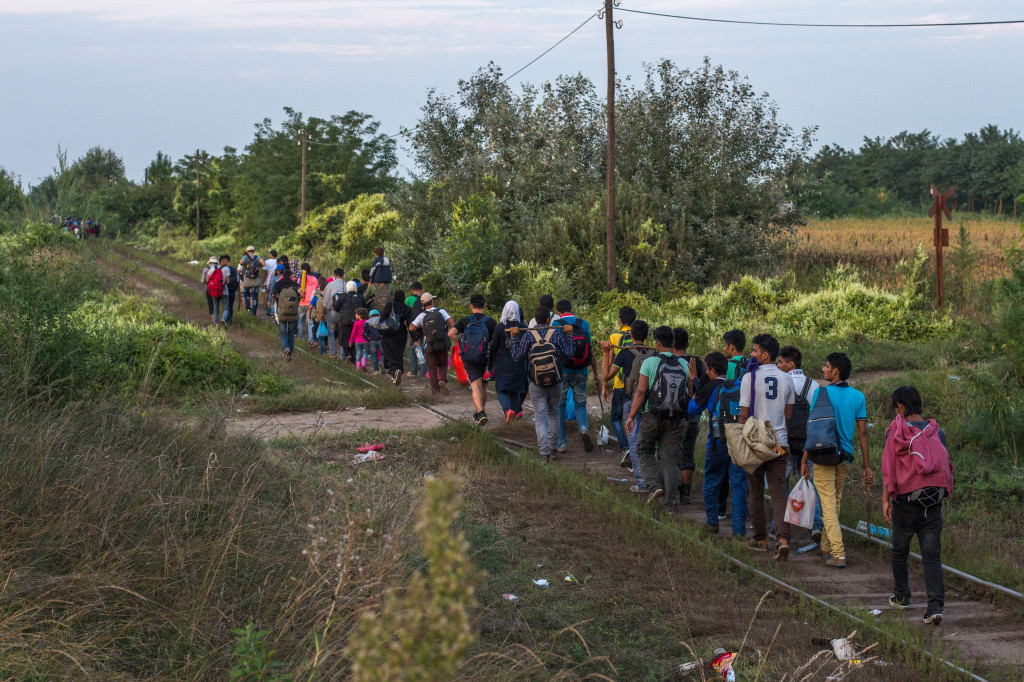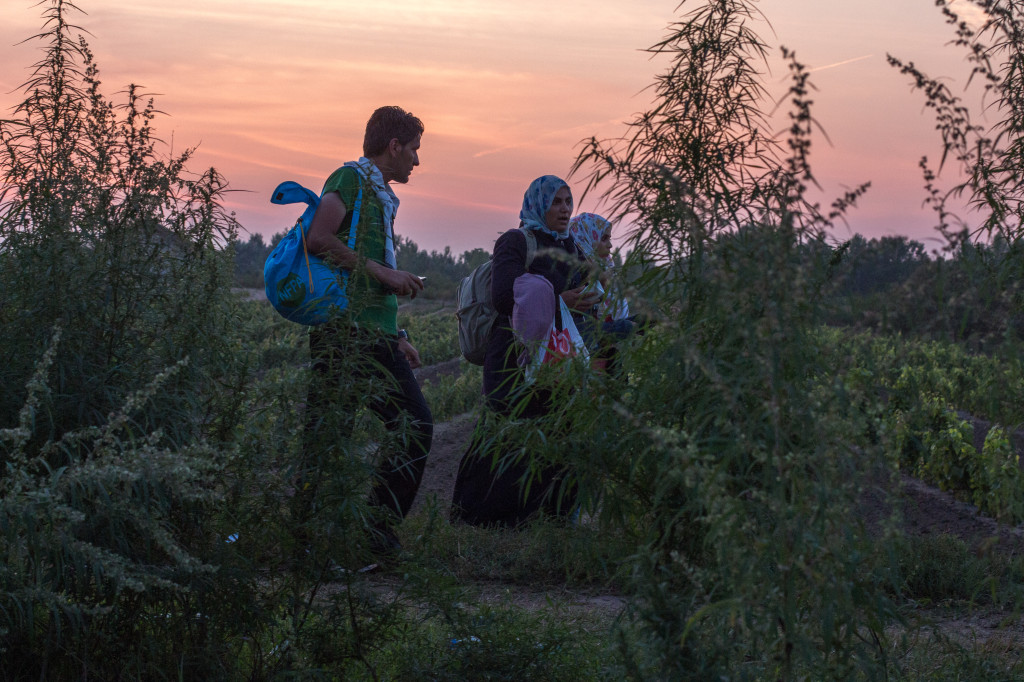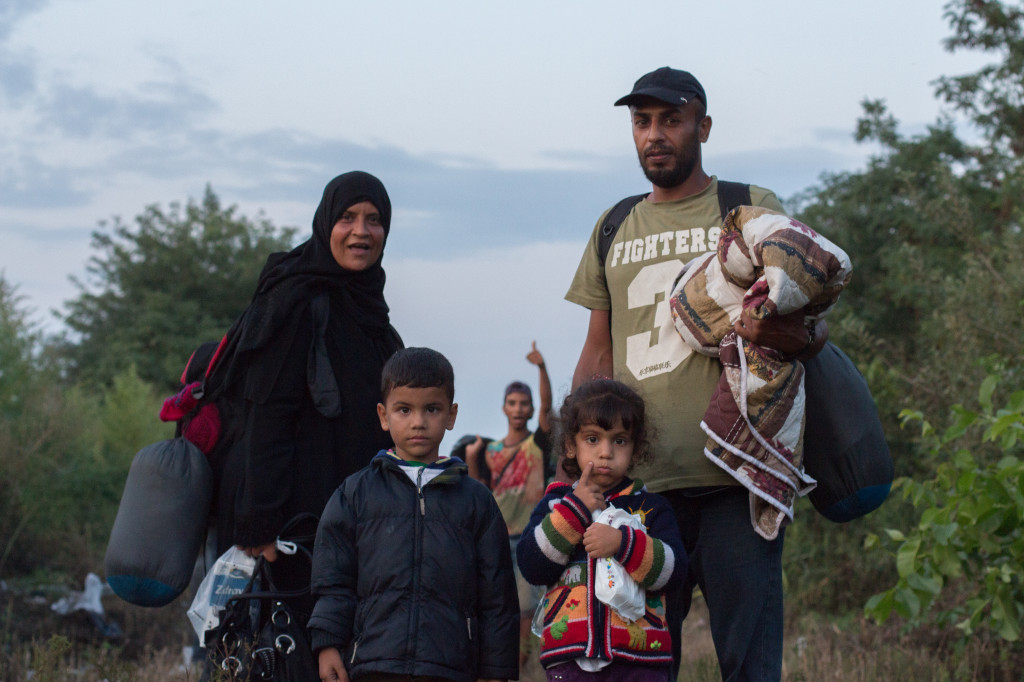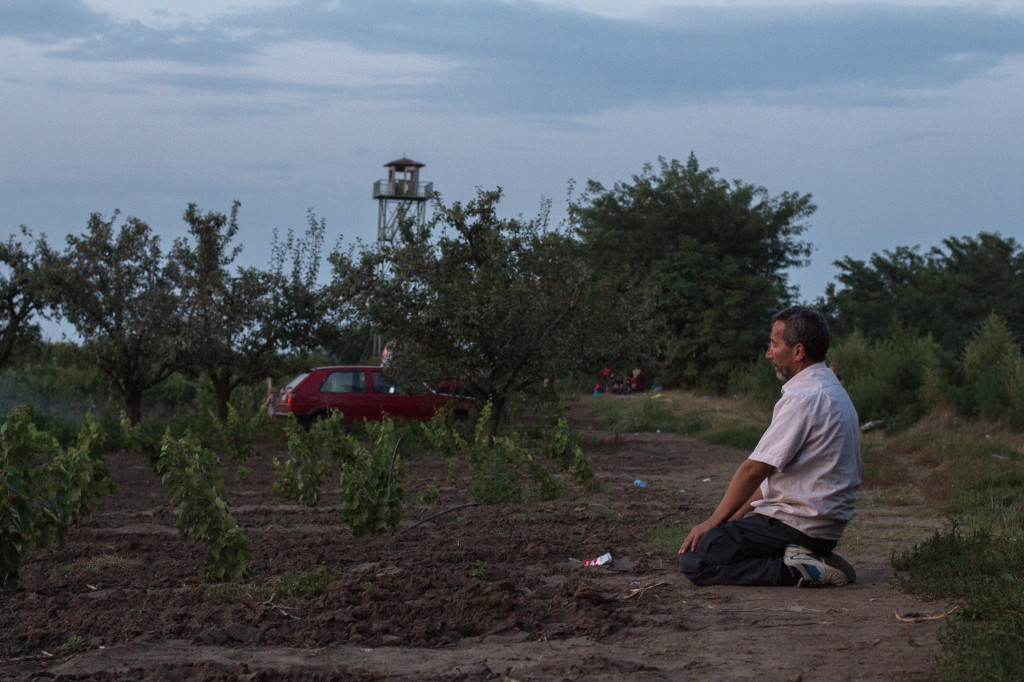What’s happening to refugees along the so-called ‘Balkan corridor’? Catherine Baker offers a smart and comprehensive take, along with a list of potentially helpful resources for refugees in the region. If you have any further information that may be of help, please send it along to editor@balkanist.net, as we hope to contribute in some small way to the work a group of activists are doing on behalf of refugees who’ve arrived in the Balkans. Thank you, as always, to all of our readers and writers and editors and volunteers, who have always made this project what it is.
All photos are of refugees crossing from Serbia to Hungary by Julia Druelle for Balkanist.
In the early 2000s, as Slovenia prepared to join the EU and Croatia waited for its relations with the ICTY to be judged acceptable, post-Yugoslav film-makers became fascinated with the figure of the undocumented Chinese migrant. The plots of films such as Varuh meje (Guardian of the Frontier, 2002), Rezervne deli (Spare Parts, 2003), Kajmak i marmelada (Cream Cheese and Jam, 2003) and Put lubenica (The Melon Route, 2006) turned on the organised smuggling of Chinese migrants into the EU, enabling the ‘Balkan’ criminal networks that facilitated Chinese movement through this intermediate territory (or in one case the police who tried to apprehend Chinese migrants travelling into Slovenia from Croatia upriver) to become settings for their directors’ tales of fragmented post-Yugoslav society. Sunnie Rucker-Chang, in a book chapter on post-Yugoslav films about Chinese migration that deserves to be more widely read, argues that the films ‘us[ed] the Chinese as a proxy for unrecognizable change’, connecting ‘some problematic aspect of [post-Yugoslav] transition – usually crime or social deviance – to the Chinese’ (p. 201).[1]
These were not films about the experiences of undocumented Chinese people trying to reach the EU, but about dislocations the directors wanted to use them to symbolise – the same narrative technique that Kevin Moss and Mima Simic critically argue characterised post-Yugoslav directors’ representations of gays and lesbians in the same period.[2] (Indeed, Varuh meje places both the silent Chinese migrants and its lesbian and bisexual white Slovene protagonists as targets of the mysterious small-town nationalist politician that the Ljubljana students encounter on their canoeing trip.)

Human trafficking is not the only context in which post-Yugoslav film-makers represented Chinese migration – Rucker-Chang also discusses Oprosti za kung fu (Sorry About the Kung Fu, 2004), where a returning Croatian refugee gives birth to a half-Chinese baby, and a group of Serbian films depicting Chinese migrants who have settled to open restaurants and markets – but is probably the single most common form of depicting Chinese presence, notably in the films from Slovenia. Released one or two years before Slovenia would join the European Union and enter the space of the Schengen Agreement, they implied that one facet of post-Yugoslav modernity was the novel visibility of racialised difference in everyday Slovenian life, and Slovenia’s participation in the pan-European project of regulating who should or should not have the right to enter and settle in European space.
Rucker-Chang’s book chapter, and the volume it comes from (Chinese Migrants in Russia, Central Asia and Eastern Europe, edited by Rucker-Chang and Felix Chang in 2011), is remarkable for placing these questions at the centre of how it understands the post-Yugoslav region’s international position – the kind of agenda that will need to be embedded much more widely in south-east European studies in order to contextualise scenes such as those of Macedonian police confronting thousands of migrants this weekend after Macedonia temporarily closed its border with Greece.
The early 2000s trafficking films depicted undocumented migration as a flow that goes unnoticed to citizens except those who (themselves socially marginal – yet still belonging to national society in a way that is unavailable to the migrants) participate in the underworld activity of moving them on, with small groups concealed in vehicles or led across rivers at a time. In contrast, the routes of migrants/refugees – many fleeing conflict in Syria, Iraq, Libya and Afghanistan – attempting to travel through the Western Balkans this summer en route to the EU have created not just domestic political disputes but an international spectacle. Media attention has turned from Lampedusa, Kos and Calais to places such as Gevgelija, where last weekend migrants trying to board trains and travel further north took direct action against the Macedonian police lines.

Schengen and the ‘Balkan corridor’
Gevgelija’s railway station makes it a node on the so-called ‘Balkan route‘ or ‘Balkan corridor’ which migrants who have managed to reach Greece (by boat across the Mediterranean, or by crossing from Turkey) follow to reach their intended destinations in the EU. Until June, they had to walk clandestinely through Macedonia and were vulnerable to robbery and even kidnap. A new Macedonian asylum law in June created a temporary asylum status where migrants had 72 hours to transit the country and get to Serbia – where Belgrade has become another waystation before they travel on to Hungary. The fastest way, if someone can find space to board, is using south-east Europe’s international trains.
On 20 August, however, the Macedonian government closed the Greek/Macedonian border and declared that it could no longer manage the 1,000 or more people per day who were coming to Gevgelija seeking onward travel. Scenes of Macedonian police firing stun grenades and tear gas at refugees – desperate to travel on to Hungary before the Hungarian government could finish fencing off its own border with Serbia – amplified a humanitarian crisis where the most visible agents of the violence are the Macedonian police officers dressed in camouflage uniforms and riot gear, but where more complex structures of power, finance and ideology need to be recognised in order to understand the politics of migration, racism and solidarity along the ‘Balkan corridor’.
Hungary’s own closing of its border, which Dario Cepo called ‘a cynical twist in history’ after the flight of Hungarian refugees in 1956 and the consequences of Hungary’s opening its border to East Germans in 1989, was announced in June and follows months of anti-immigration rhetoric by the Hungarian prime minister, Viktor Orban. The spotlight of the European refugee crisis, now the continent’s largest since the aftermath of the Second World War (and with a death toll far exceeding the numbers shot at the Berlin Wall by East German border guards), has shifted to the ‘Balkan corridor’ as people hurry to complete the part of their journeys through the Balkans before having to access the Schengen area another way.

Schengen, the space within the EU where states have agreed to mutually lift their national border controls (enabling travel from, say, Hungary to Germany, or Italy to France, though not from any Schengen member state into the UK), is much more than an ‘area’. It is a political compact, where, as Ruben Zaiotti writes, the ease of movement within the Schengen Area once admitted is exchanged for the ‘exclusionary underpinnings’ (2007: 554) of a strict and frequently humiliating visa regime which explicitly or practically prevents all but the wealthier non-EU citizens from legally entering the EU, and for a racialised system of profiling that states depend on in determining who should be allowed; it is a symbolic obstacle, which exacerbated eastern Europeans’ (perhaps especially post-Yugoslavs’) feelings of marginalisation within Europe as the visa application process reminded them of the unequal terms on which they belonged; it is a system of physical power, intelligence-sharing and surveillance technology that shifts responsibility for regulating overland border-crossing to the states on Schengen’s external borders, organised through the EU border management agency known as Frontex. It is a network that does not defend states and the EU from other states, but from ‘a host of transnational, social threats, […] often personified in the racialized figure of Islamic and nonwhite people’ (Walters 2002 [£]: 570[3]) – individuals, but people whom border management ideology strips of their individuality.
In south-east Europe, however, the Schengen borders and the EU’s own external borders are a moving wall, with complex implications for narratives of national identity. The ‘visa liberalisation‘ agreements of 2009-10, incentives for post-Yugoslav states to progress through the EU’s stabilisation and association road-maps, removed Serbia, Montenegro, Macedonia, Bosnia-Herzegovina and Albania from the list of states whose citizens require visas to enter the Schengen Area (though did not extend to the non-Schengen UK); from being targeted as Schengen’s presumed undesirables, Western Balkan states were now expected to participate in guarding it from outside, after a certain liminal period (when they were ‘harmonising’ their border management practices with the EU but visa requirements had not yet been lifted) when they would have been in both relationships with Schengen at the same time.
Moreover, gaps still remain: Kosovo’s passport-holders still require visas for Schengen and, in Vjosa Musliu’s words, ‘pretty much anywhere’; the EU’s safe-listing of Western Balkan states for asylum purposes has impeded Roma asylum-seekers who still face persecution from their home states.

Standing at the bulwark of Europe
Schengen members Slovenia and Hungary, plus Croatia which began applying for Schengen membership this year, are among the states required to manage the EU’s external borders – a role that lends itself well to contemporary incarnations of the ‘bulwark of Europe’ or ‘bulwark of Christendom’ narratives, well-known for instance from Croatia or Poland, where a certain nation can imagine itself as having historically defended Europe or Christendom against threats from the East. (Other narratives of standing at the ‘gates of Europe’, meanwhile, have inspired the contemporary far right’s narrative of itself as Europe’s last defence against Islamisation.)
Sabina Mihelj suggests that ‘the symbolic position of Slovenia as a devoted guard of Europe’s borders’ (2005 [£]: 122) was institutionalised in the amendments to Slovenia’s asylum laws made in 2000-01 after unexpected rises in asylum applications (from 776 in 1999 to 12,943 in 2000) and undocumented migration from the Middle East and Asia – the same context in which the Slovenian human trafficking films were being conceived.
For Mihelj, ‘Europe’ appeared to represent a ‘wishful projection’ (p. 110) in the national identities of Slovenia and other central and eastern European states – an ‘affective’, almost emotional investment in belonging to simultaneously a community of imagined values and a set of structures which bring pooled state power to bear on determining who can enter, and participate in the social and political life of, the territory linked to that community.
The emotions behind such a longing for belonging are those which, following Sara Ahmed, bind individual subjects to the nation in a way that depends on the exclusion of others – above all ‘the figure of the asylum seeker and the international terrorist’ (Ahmed 2004: 119), Ahmed considered, in contemporary constructions of the West and Europe.
Indeed, post-Yugoslav states have been implicated in guarding not just against the asylum seeker but against the terrorist. In 2003, for instance, Macedonian police arrested Khaled El-Masri during a cross-border bus journey, mistaking him for a suspected terrorist, and interrogated him for three weeks before handing him over to the CIA for the unaccountable process of ‘extraordinary rendition’. El-Masri spent four months at a secret CIA detention facility in Afghanistan. His case against Macedonia at the European Court of Human Rights, which ruled in his favour in 2012, was the first time a court had found that extraordinary rendition constituted torture.The UN Human Rights Council secret detention report of 2010 alleged that Camp Bondsteel in Kosovo and Eagle Base (near Tuzla) in Bosnia had both been used as secret CIA detention sites, as had facilities in Poland, Lithuania and Romania.

US forces had also been able to arrest suspects directly in post-Yugoslav states, as in the ‘Algerian Six’ case in Bosnia, where six Algerians were arrested the day after 9/11 (on suspicion of conspiring to bomb the US Embassy in Sarajevo) and taken to Guantanamo Bay. This too resulted in legal proceedings, with the US Supreme Court ruling in 2008 that the US constitutional right to habeas corpus did extend to prisoners at Guantanamo. Meanwhile, in the public face of the War on Terror, Western Balkan states aspiring to join NATO have been able to demonstrate their readiness and to gain their operational experience by sending contingents to the coalitions in Iraq and Afghanistan. The project of integrating Western Balkan states into the ‘Euro-Atlantic institutions’, chiefly the EU and NATO, links border security practices and participation in the War on Terror materially as well as discursively – yet in a way that depends on narratives about what ‘Europe’ is there to provide security against.
The weekend’s scenes at the Macedonian border, therefore, present much more than a story about Macedonian police tactics – even though the government of Nikola Gruevski is no stranger to turning a crisis into a spectacle, and, as Ivana Jordanovska writes, ‘[t]he ordeal of hundreds of children crying at the border of our country, afraid of the stun grenades and tear gas, forever bearing the imagery of a Macedonian police uniform as one of the scariest figures of their childhood’ will remain a legacy of the crossing for the refugees at Gevgelija that day.
Police and border guards on the EU’s external borders are trained and coordinated through European institutions, including the Frontex programme on which almost a billion euros have now been spent; the contemporary form of police paramilitarisation which can be read from the Gevgelija photographs is a global configuration of technology, capital and power.
Yet there are also many potential narratives of solidarity between citizens of post-Yugoslav states and today’s refugees: based on memories of displacement and hospitality in the 1990s; based on anti-nationalist activism against immigration controls; based on a universalist humanitarian ethic; perhaps even some based on connections between Yugoslavia and countries like Syria during the Non-Aligned Movement, a period where quite a few Yugoslavs’ life courses crossed into Syria and some Syrians’ vice versa.

Energies of solidarity
As in Greece (where residents of Thessaloniki have been organising to feed and support refugees for months), Hungary (where the immigrant/refugee/Hungarian coalition Migszol formed in Szeged, and Migration Aid in Budapest, to assist refugees at ‘transit zones’) or France (where Calais Migrant Solidarity is monitoring police violence against migrants at the improvised camps near the Channel Tunnel), self-organised solidarity groups have formed at all the nodes along the ‘Balkan corridor’ – from the Help the Migrants in Macedonia group (which has appealed for donations from inside and outside Macedonia) and Legis (helping to deliver food, water and supplies to migrants camped outside Macedonian stations), to groups collecting and delivering support from Croatia and Bosnia, to initiatives in Belgrade that the Centre for Euro-Atlantic Studies has helped to coordinate (including appeals for volunteers to deliver essential goods to refugees at Belgrade station in person, and an online map of resources for refugees which is now being crowd-translated into Arabic). Indeed, the CEAS map has extended into a Balkan Refugee Map which, at the time of writing, was starting to cover Skopje, Budapest, Sofia and Thessaloniki as well as Belgrade – and continued to be in need of content and translators.
The energy of these solidarity groups recalls responses to the floods of 2014, which again mobilised pan-regional self-organised expressions of solidarity in the face of ineffective governmental reactions. As with the floods, the practical question once the moment of crisis has passed is what kinds of structures can sustain these solidarities between such moments when national political systems – conveniently for the political and financial interests of existing elites – leave very little space for them to be expressed.
At the same time, there may and should be implications for the questions that researchers ask about the region. Just as the global financial crisis of 2008 seems to have helped questions of social inequalities and economic precarity return to the agenda for explaining the break-up of Yugoslavia and its consequences, the 2015 refugee crisis may yet accelerate the momentum to ask how the region’s national identities have been embedded in ideologies of race and whiteness that have so often given meaning to ideas of European belonging. This is a different kind of postcolonial lens to the one that is most commonly applied to the Balkans, and sometimes an uncomfortable one to apply. The tension between them is there in the silences that, Stef Jansen noted, ran simultaneously with Bosnians’ and Serbians’ anger at their own exclusion from ‘Europe’ through the visa regime:
Almost nobody compared EU visa restrictions for BiH or Serbian passport holders to that of people from, say, Asia or Africa. And if anyone did, it was often precisely to prove the point of humiliation. Some expressed exasperation at being ‘in the same newspaper reports with Rwanda,’ and others made rueful comments to me about having become the object of anthropological research, a discipline considered to be about ‘primitive tribes’.
In a post-Cold War context where capitalist liberal democracy was projected as the only possible route of development, this resonated with the Eurocentrism so central to the EU-project itself. The relentless calls by EU politicians that ‘BiH and Serbia prove their commitment to Europe’ implied that they distance themselves from non-Europeans who might or might not share some of their predicaments. At every step on the ‘road to Europe’ – built around the progressive fulfilment of conditions and a presumably known destination – EU officials exhorted local politicians to raise the outer European fence in order to be allowed within it.
Simultaneously, however:
The Yugoslav lands, lest we forget, have the historical experience not of colonizers but of colonies, having been parts of the Ottoman and Austro-Hungarian empires. Moreover, through the Non-Aligned Movement, they have been central to a non-Eurocentric, anti-imperialist global alliance. Yet that engagement is part of the region’s socialist history, which has been declared illegitimate as a foundation for its future by both local and EU elites. When anti-Eurocentrism might be a luxury that those on its margins can only afford at the price of their own exclusion, in this geopolitical moment Eurocentrism is the channel through which they can prove their European-ness in terms acceptable to the EU.
Jansen’s final question looked into a future when Bosnia and Serbia themselves might have joined the Schengen regime, asking how their citizens’ own experiences of exclusion from Europe might shape their relationships towards the contemporary EU bordering project:
If and when BiH and Serbia join the Schengen zone – or some successor of it – what will be the legacy of the furious resentment of the first two post-Yugoslav decades? Will their citizens prove to be exemplary Europeans, approaching migration matters with selfishness and inhospitality? Or will there be a hopeful residue of the anger? As rows of other people, seeking to travel to Europe, are being treated as ‘idiots’ in the queues under the EU flags in front of some BiH or Serbian embassy, will anyone be able to turn the memory of their own humiliation into a source of solidarity?
Some hint of Jansen’s speculation is already becoming visible in Gevgelija, in Belgrade, and indeed in Thessaloniki and Szeged and Budapest.

Groups currently supporting migrants in the areas discussed here include:
Bosnia-Herzegovina
- Podrška za izbjeglice i migrante, BiH (including groups in Bihac, Sarajevo, Zenica and Zavidovici at the time of writing)
- Bosanci, pomozimo izbjeglicama u Beogradu (taking goods to refugees in Belgrade)
- Pomozi.ba (appealing for donations)
- Red Cross BiH appeal
Croatia
Greece
- Refugee Solidarity Movement Thessaloniki – with information for remote supporters here
Hungary
- Migszol (Szeged)
- Migration Aid (Budapest)
Macedonia
- Help the Migrants Macedonia – with this appeal for donations
- Legis
- Otvorena Porta/Open Gate – La Strada Macedonia
- UNICEF Macedonia
- Solidarnost
- Macedonian Helsinki Committee (drop off center for food and clothing)
Serbia
- Refugee Aid Serbia (assisting refugees at transit point in Belgrade)
- Centre for Euro-Atlantic Studies (list of goods currently needed in Belgrade)
- Podrška i solidarnost za izbeglice sa Bliskog istoka i severa Afrike
- No Border Serbia
- Group 484
- Belgrade refugee resources map (translators into Arabic needed; being extended into Balkan Refugee Map)
Pan-regional resources
- Balkan Refugee Map Translation Project
- Nijedan čovek nije ilegalan (sharing information in Bosnian/Croatian/Serbian)
Many initiatives are small, and this won’t be an exhaustive list. Thanks to Elissa Helms, Kole Kilibarda, Nidzara Ahmetasevic and Isabel Stroehle for advice on links to include here.
[1] While her chapter doesn’t mention Varuh meje, its representations are very much in the same vein as the other Slovenian films. [2] Moss and Simic’s article isn’t open access, but this book chapter by Moss covers similar problems of ‘queer as metaphor’ in central and eastern European film. [3] At the time of writing, also available online here.
This article was originally published on Catherine Baker’s website, and she has generously given us permission to republish the piece in its entirety here. We again invite readers with more resources of potential use to refugees to contact Balkanist at editor@balkanist.net with information we might add.
All photos are of refugees crossing from Serbia to Hungary by Julia Druelle for Balkanist. Find more of her work, and information about purchasing the rights to her photography at http://juliadruelle.tumblr.com.

